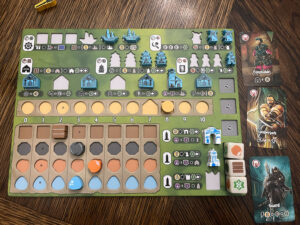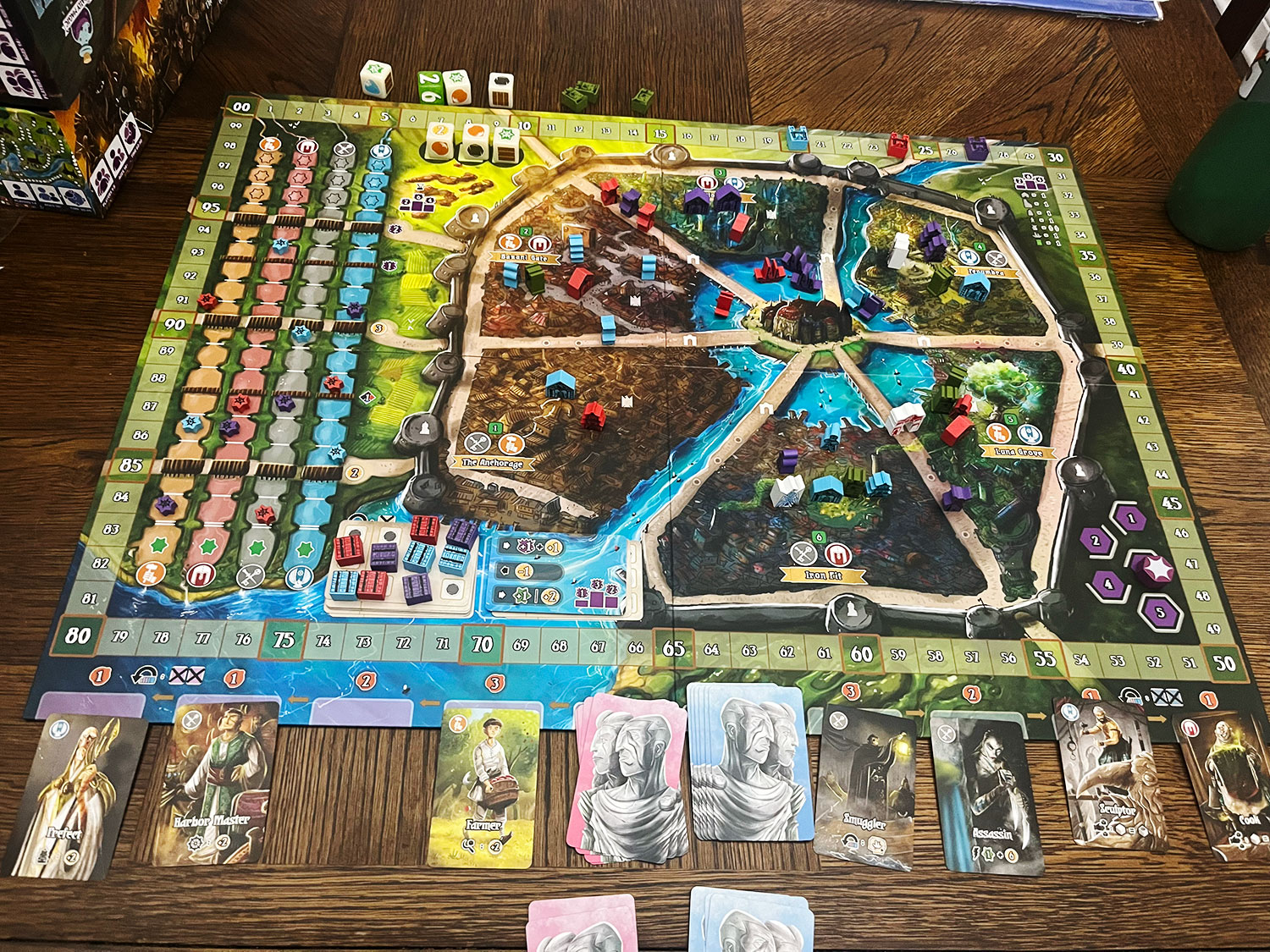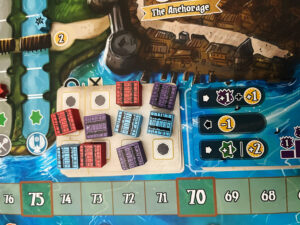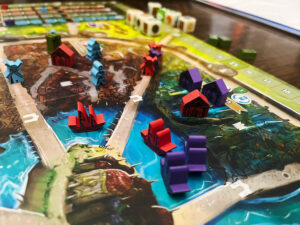 I am returning to the Valeria Universe of games to review Castellans. Thus far my travels to Valeria have been mixed, Dice Kingdoms of Valeria is my favorite roll and write, while Guild Academies of Valeria is the game that got my second-lowest score ever. Will the third time be a charm or a strike-out? In Castellans, the westernmost city of Valeria, Kosk, is in need of a Castellan to manage the city’s development and day-to-day operations. You will compete against your opponents to be the best Castellan by developing districts, collecting resources, buying and selling goods at the wharf, gaining influence within the guilds, and encouraging the best citizens of Valeria to move to the frontier.
I am returning to the Valeria Universe of games to review Castellans. Thus far my travels to Valeria have been mixed, Dice Kingdoms of Valeria is my favorite roll and write, while Guild Academies of Valeria is the game that got my second-lowest score ever. Will the third time be a charm or a strike-out? In Castellans, the westernmost city of Valeria, Kosk, is in need of a Castellan to manage the city’s development and day-to-day operations. You will compete against your opponents to be the best Castellan by developing districts, collecting resources, buying and selling goods at the wharf, gaining influence within the guilds, and encouraging the best citizens of Valeria to move to the frontier.
Gameplay Overview:
Castellans takes place over five rounds and each round has four phases: Draft, Action, Score, and Reset. The gameplay combines Area Control and Dice drafting in a fun, somewhat unique way.
Draft phase: Players draft the resource dice until each player has three. The remaining three dice are stored on the game board to be used by Manor powers and certain citizen cards.
Each player gains the resources on the dice that they drafted (Gold, Wood, Stone, Food, Magic, or Influence). Magic can be used to augment payments requiring Wood, Stone, and Food. When you earn influence, you select which guild you want to influence and move up that guild’s track. Each track has multiple bridges and when your influence marker crosses a bridge you gain a bonus. At the end of the game VP are awarded based on the ranking of your influence in each guild.

Action phase: Players spend their drafted dice to perform one primary action.
1. Wharf – Place Cargo tokens to buy or sell a resource. The Wharf has two very important sub-Actions:
Shipyard: pay two wood plus one gold per Ship in the district to place a ship in that district.
Sail: Spend two gold to move a Ship from one district to another.
2. Harvest – Receive the Gold, Resource, and Influence shown on all three of your dice, plus gain one influence push on a Guild Track of your choice.
Harvest sub-Action: Windmill: Spend two food plus one Gold for each Windmill token on your chosen road to place a Windmill on a road.
3. Manor – Place a Manor in a district. Each Manor has a unique power, from the most powerful, Lighthouses, which are unique Manors that prevent other players from placing Lighthouses in that district and earns you two VP for every ship token in your district, to the most straightforward a Merchant’s Manor which earns you two VP every time you take a Ship Action.
4. Temple – Place one Temple in a district, plus gain two Influence pushes on both of the District’s Guild tracks.
5. Recruit – Draft a Citizen card and gain one Influence push based on the card and one on one of the District’s Guild tracks. Each Citizen card has a unique power that is either instant or that you receive when you take a specific action. You also place a Citizen in the district of your choice.
6. Monument Actions: There are three Monuments available for building and they each have a unique power.
Scoring Phase: Players score points for controlling districts, monuments, and having cargo crates on wharf cards.

Game Experience:
Let me start by congratulating Daily Magic games on fixing my first complaints of Guild Academies of Valeria… the Rulebook is easy to read and follow and I found no blatant errors.

Area Control games are not my favorite genre, but this game plays differently than most area control games as the ways that you gain control are varied and for the most part static, except for the ships, I particularly enjoy that the only mobile units are the ships and the strategy of moving, not moving, or where you choose to move your ships was very fun.
Limiting the area control scoring to three zones for rounds 1-4 and knowing what zones will be scored next round makes you really consider the placement of each Manor, Lighthouse, Temple, and Citizen which ups the strategy. In 2-3 player games, area control games can become one-sided quickly, but Castellans solves this with the imaginary Green player, and it works to force people to consider how to gain more control than the imaginary player too.

My biggest/only complaint is there are so many things to remember/consider on each turn that for newer players or players with analysis paralysis it can make this game take forever. On each turn, you need to manage your resources, consider the bonus die when selecting your action, make sure you’re advancing on the correct Guild track, and that you’re doing the math of the control points for all players, plus ensure you optimize the wharf scoring, and gain enough gold to buy monuments. That being said, with so many things ways to outmaneuver your opponents it leads to a lot of variability and this is great for my desire to replay this game.
Solo Mode: There is a solo mode and as mentioned in every review, I do not play Solo modes. This one adds four large format cards, three of which are the double-sided Opponent cards, and provides six adversaries. The fourth card is a Charts card that interprets the roll of the decision die to determine the choice of available options for the Opponent’s actions. The flow of the game follows the same rules as the main game using the previously mentioned cards to determine the draft and action choices of the opponents.
Final Thoughts:
This game redeems the Valeria Universe of Games for me after the miss that was Guild Academies. The randomness of the die roll makes the available resources unknown going into each round which makes draft order important. The ability to use magic as a wild only if you have one of the required resource types is a great way to manage wilds and to force better resource management. In my opinion, Castellans is best at three players with the imaginary green player offering enough variability to not need the increased time of a higher player count.
Also, for the Lore Nerds out there, you know who you are. You will really appreciate the supplemental book Chronicles of Kosk: The Lives, Locations, and Legends of Valeria’s Westernmost City.
Final Score: 3.5 Stars – A Solid game and a welcomed return to Valeria.
 Hits:
Hits:
• Mihajlo Dimitievski’s art has never disappointed and continues to be great in this game.
• The components are of high quality and the storage containers make for easy setup and clean up.
• The Green imaginary player makes this game playable with 2-3 player counts, which is not always the case with Area control games.
• The sail action allowing you to move ships keeps all players on their toes and can alter the area control scoring in unexpected ways, as does the fact that monument scoring occurs in all districts while the area control only scores in three districts.
Misses:
• The Citizen cards feel under powered and did not appear to influence the game enough.
• Valerian games frequently have too many ways to score, and this is true here.





















